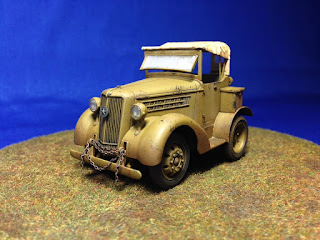Dan Salamone has very kindly shared these images of two of his recently completed 1/48th scale Japanese airfield vehicle projects.
The Army Isuzu TX40 airfield tug (above) was converted from the Hasegawa 1/48 cargo truck version. Dan started this project back in 2012, and based it on an image showing two of these vehicles on the tarmac at Hamamatsu airbase towing Ki-21 bombers.
The conversion involved narrowing the cab and bench seat and scratch building the rear fenders, left door, equipment bins on the fenders and rear of the vehicle, as well as shortening and detailing the frame and tow hitch.
Dan also scratch built the roof by building up a frame with plastic rod and strip, then covering it with tissue soaked in white glue.
The vehicle was then airbrushed with a custom mix for IJA khaki, using Vallejo acrylics. The roof was sprayed with Tamiya paint, weathering was done with Vallejo washes and artist's oils. The final clear coat was Gunze matt lacquer. The result is an excellent and unique model of an interesting vehicle, although Dan hasn't indicated whether he plans to build a 1/48th 'Sally' bomber to go with it!
The splendid looking IJN fuel truck model (above) was made from the 1/48 Hasegawa Isuzu Type 97 kit, built pretty much from the box. Dan covered the roof with tissue soaked in white glue to give the appearance of canvas. The model was finished with Tamiya paints from spray cans, weathered with Vallejo acrylics and artists oils.
Dan noted that IJN fuel trucks usually displayed a light colored lateral band around the fuel tank and comparing those with aircraft in photographs, concluded that the band was most likely yellow.
Some units displayed numbers on the tank as well, with the first number identifying the vehicle and the second number indicating the octane of the fuel it carried. IJA fuel trucks did not show the colored bands or the numbers, but almost every image Dan has seen shows a canvas tarp covering the fuel tank.
This particular vehicle is patterned after images of trucks used by the 302nd NAG, based at Atsugi.
With special thanks to Dan for sharing these images of his superb pair of airfield vehicles. An inspiration.
Image credits: All photos © 2015 Dan Salamone















































